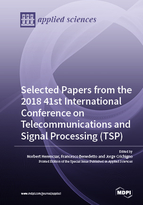Selected Papers from the 2018 41st International Conference on Telecommunications and Signal Processing (TSP)
A special issue of Applied Sciences (ISSN 2076-3417). This special issue belongs to the section "Electrical, Electronics and Communications Engineering".
Deadline for manuscript submissions: closed (7 November 2018) | Viewed by 56575
Special Issue Editors
Interests: analog electronics; analog filters; circuit theory; current-mode circuits; fractional-order components and systems synthesis; MOS-only circuits
Special Issues, Collections and Topics in MDPI journals
Interests: ground-penetrating radar; radar signal processing; software and cognitive radio; digital signal and image processing for telecommunications and economics
Special Issues, Collections and Topics in MDPI journals
Interests: wireless and optical networks; graph theory; mathematical optimization; network security
Special Issues, Collections and Topics in MDPI journals
Special Issue Information
Dear Colleagues,
In cooperation with the IEEE Region 8 (Europe, Middle East and Africa), IEEE Greece Section, IEEE Czechoslovakia Section, and IEEE Czechoslovakia Section SP/CAS/COM Joint Chapter, the 2018 41st International Conference on Telecommunications and Signal Processing (TSP) is organized by seventeen universities, from the Czech Republic, Hungary, Turkey, Taiwan, Japan, Slovak Republic, Spain, Bulgaria, France, Slovenia, Croatia, and Poland, for academics, researchers, and developers, and it serves as a premier annual international forum to promote the exchange of the latest advances in telecommunication technology and signal processing. The aim of the conference is to bring together both novice and experienced scientists, developers, and specialists, to meet new colleagues, collect new ideas, and establish new cooperation between research groups from universities, research centers, and private sectors worldwide. Authors of selected high-quality research papers will be invited to submit their extended version for publishing in Special Issue "Selected Papers from the 2018 41st International Conference on Telecommunications and Signal Processing (TSP)" in Applied Sciences.
Assoc. Prof. Norbert Herencsar
Assoc. Prof. Francesco Benedetto
Assoc. Prof. Jorge Crichigno
Guest Editors
Manuscript Submission Information
Manuscripts should be submitted online at www.mdpi.com by registering and logging in to this website. Once you are registered, click here to go to the submission form. Manuscripts can be submitted until the deadline. All submissions that pass pre-check are peer-reviewed. Accepted papers will be published continuously in the journal (as soon as accepted) and will be listed together on the special issue website. Research articles, review articles as well as short communications are invited. For planned papers, a title and short abstract (about 100 words) can be sent to the Editorial Office for announcement on this website.
Submitted manuscripts should not have been published previously, nor be under consideration for publication elsewhere (except conference proceedings papers). All manuscripts are thoroughly refereed through a single-blind peer-review process. A guide for authors and other relevant information for submission of manuscripts is available on the Instructions for Authors page. Applied Sciences is an international peer-reviewed open access semimonthly journal published by MDPI.
Please visit the Instructions for Authors page before submitting a manuscript. The Article Processing Charge (APC) for publication in this open access journal is 2400 CHF (Swiss Francs). Submitted papers should be well formatted and use good English. Authors may use MDPI's English editing service prior to publication or during author revisions.
Keywords
- Telecommunications
- Information Systems
- Network Services
- Network Technologies
- Telecommunication Systems
- Simulation and Measurement
- Analog Signal Processing
- Audio Signal Processing
- Biomedical Signal Processing
- Digital Signal Processing
- Image and Video Signal Processing
- Speech and Language Processing








